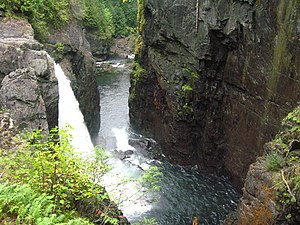Elk Falls Provincial Park
|
Elk Falls Provincial Park
|
||
|
The Elk case |
||
| location | British Columbia (Canada) | |
| surface | 10.87 km² | |
| WDPA ID | 18635 | |
| Geographical location | 50 ° 2 ′ N , 125 ° 18 ′ W | |
|
|
||
| Setup date | Dec 20, 1940 | |
| administration | BC parks | |
The Elk Falls Provincial Park is a 1,087-hectare Provincial Park in the Canadian province of British Columbia . It is located near the town of Campbell River on Vancouver Island and has a large campsite. The park is located in the Strathcona Regional District and is accessible from Highway 28 .
investment
The park is about two kilometers from the city of Campbell River. It is located at the eastern end of John Hart Lake on the Campbell River and is intersected by Highway 28. The main attraction of the park is the Elk Falls , an approximately 25 meter high waterfall with which the Campbell River falls over a cliff into a canyon made of high rock walls. The campsite is located about four kilometers downstream at the confluence of the Quinsam River with the Campbell River.
The park is a category II protected area ( national park ).
history
The forest on the park's grounds was one of the first areas on Vancouver Island to be cleared because the wood could be easily transported across the Campbell River. Most of the park area was cleared by 1929. In 1938, a forest fire devastated nearly 300 square kilometers of cleared woodland near Campbell River. The burned land was extensively reforested. The Provincial Park was established on December 20, 1940 and originally comprised 1,124 acres of land. In 1946 the park was reduced by 102 hectares for the construction of the John Hart Dam and the associated hydroelectric power station. The dam dammed the Campbell River into John Hart Lake in 1948, and the hydroelectric power station, the John Hart Generating Station , has served as a paper and pulp mill since 1952. Thanks to the hydroelectric power plant, the amount of water in the Elk Falls can be reduced considerably in summer. Various smaller assignments and increases in area led to the current park size of 1,087 hectares since 1946.
Flora and fauna
Within the British Columbia ecosystem, the park area is assigned to the Coastal Douglas-fir Zone . These biogeoclimatic zones are characterized by a similar climate and the same or similar biological and geological conditions. This results in a very similar population of plants and animals in the same zones.
The park is primarily forested with secondary forests of Douglas fir , coastal fir , giant arborvitae , coastal pine , western Weymouth pine , red alder , oregon maple and other trees. The undergrowth is typical of the coast. There are, among other things, the Shallon shamberry , forest foam spar , moss bells and the shield fern type sword fern . In the immediate vicinity of the waterfall is the only significant Douglas fir primeval forest on Vancouver Island north of MacMillan Provincial Park .
The Quinsam and Campbell Rivers are spawning areas mainly for king and silver salmon and therefore the scene of salmon migrations. In addition to salmon, there are also rainbow trout , cutthroat trout and char in the river . Mainly smaller mammals like raccoons , chipmunks and muskrats live in the park . At the Beaver Pond and the Kingfisher Pond live beaver , also come in the park Heron , killdeer , Bering sea gulls and other bird species. Deer occasionally come to the park in winter.
activities
There is a fee to visit the park from May to October. The park is considered one of the best salmon fishing spots in Canada all year round. This and the waterfall make the park one of the most visited parks on Vancouver Island. Six kilometers of hiking trails run through the park and a network of forest trails borders the park. A viewing bridge leads over the canyon of the Campbell River. The Quinsam fish hatchery is located near the campsite and supplies the Quinsam River with pink salmon, king salmon, silver salmon and rainbow trout. The park has a campsite with 122 pitches on the Quinsam River. The park also has a large picnic area.
Web links
- Elk Falls Provincial Park . In: BC Geographical Names (English)
- Elk Falls Provincial Park . In: English language website of the park at BC Parks
- Information to the park on britishcolumbia.com (Engl.)
- English language database about waterfalls
Individual evidence
- ↑ World Database on Protected Areas - Elk Falls Park (English)
- ↑ Elk Falls Park - Master Plan. (PDF, 1.1 MB) British Columbia Ministry of Environment, Lands and Parks , May 1986, accessed January 1, 2013 .
- ^ Ecosystems of British Columbia. (PDF, 10.31 MB) British Columbia Ministry of Forests, Lands and Natural Resource Operations , February 1991, accessed January 1, 2013 .
- ↑ Biogeoclimatic Zones of British Columbia. British Columbia Ministry of Forests, Lands and Natural Resource Operations, accessed April 6, 2016 .

